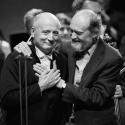Eric Whitacre – less a composer or conductor, more a global choral phenomenon. Just the mention of his name in last night’s concert introduction drew whoops and wolf-whistles from the crowd, certainly not a reaction you tend to get for Beethoven, Boulez or Cage (though perhaps the latter gets a silent cheer). Like or loathe the hype that surrounds Whitacre, there’s no denying his role in popularising choral singing, nor the pure American genealogy of his style, which we can trace back through Morten Lauridsen and Randall Thompson to Bernstein and even Copland.
Making his Proms debut with the Eric Whitacre Singers (a dream team of London’s freelancers) and the BBC Singers, with a little help from Ensemble Bash and soprano Hila Plitmann, Whitacre framed his own works within other staples of the American choral tradition. Hogan’s vibrant trio of spiritual arrangements showcased the low basses, and Bernstein’s throwaway Warm-Up established the ensemble’s athletic credentials from the off.
Vintage Whitacre – diaphanous cluster chords and foaming soundscapes
The influence of Bernstein’s scat-inspired textures had distant echoes in Whitacre’s new BBC Commission Higher; Faster; Stronger which unusually brought rhythm rather than harmony to the fore. Playing musically with the Olympic-themed idea of a race, though efficient and deft in its textural manipulations, it would have been interesting to see its central idea extended even further. Whitacre classic Leonardo Dreams of His Flying Machine (immaculately handled by the singers) reminded us of what this composer is capable of when completely committed musically to an image or theme, and I’d love to have seen this same ambition echoed elsewhere.
 The evening’s other world premiere – Imogen Heap’s The Listening Chair (Heap pictured right) – combined physical percussion and Heap’s own vocals with backing from Whitacre’s choirs. Long on concept, short on coherence, the work took longer to explain than perform, and it’s intimate, confessional content and magpie styles didn’t quite translate in the unforgiving Royal Albert Hall.
The evening’s other world premiere – Imogen Heap’s The Listening Chair (Heap pictured right) – combined physical percussion and Heap’s own vocals with backing from Whitacre’s choirs. Long on concept, short on coherence, the work took longer to explain than perform, and it’s intimate, confessional content and magpie styles didn’t quite translate in the unforgiving Royal Albert Hall.
We finished the evening with vintage Whitacre – the diaphanous cluster chords and foaming soundscapes of Cloudburst and Sleep. Passing a delicate finger-clicking from the stage out into the audience Whitacre magically summoned the rainstorm, the soft plash of droplets echoing on all sides. The harmonic and textural gestures of this work are no less evocative or precise, and with the Eric Whitacre Singers setting the character of the choral blend we were guided expertly through this musical scene.

Martyn Brabbins’ tempos kept things brisk and the right side of sentimental, letting Miah Persson’s understated soprano do the emoting (Brabbins pictured left). Andrew Kennedy’s tenor solo fared less well, more often set up to fail in competition with full choral might, and struggling a little with the crucial legato. Lively with triplets and notes tied over the barline, Howells is all about ebb and expressive freedom. Despite Brabbins’ understanding of this repertoire the chorus felt a little unwilling to release, not quite gelling as an ensemble and feeling a little stiff in all but the most euphoric of climaxes.
Given the sleeker forces of the BBCSO, Brabbins was able to shape Elgar’s First Symphony much more fluidly in the second half. Pace again was brisk without feeling rushed, but generating an organic sense of development and flow between sections. The opening string cantilena was warmly sung, restrained enough to give the orchestra somewhere to grow to over the next hour, and grow they did. The brass contributed some fantastically grotesque colours for the scherzo, and the whole symphony had a natural shape that kept the overarching journey in mind while never losing the drama of the miniature moments.














Add comment